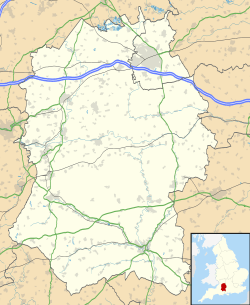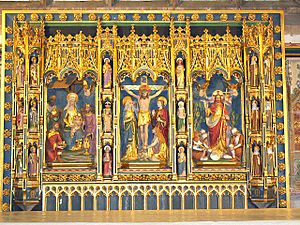St Mary's Church, Calne facts for kids
Quick facts for kids St Mary's, Calne |
|
|---|---|
| Church of St Mary the Virgin | |
 |
|
| 51°26′14″N 2°00′10″W / 51.4371°N 2.0028°W | |
| OS grid reference | ST999709 |
| Location | Calne, Wiltshire |
| Country | England |
| Denomination | Anglican |
| History | |
| Status | Parish church |
| Architecture | |
| Functional status | Active |
| Style | Perpendicular, Gothic survival |
| Years built | 12th century, restored 1864 |
| Administration | |
| Parish | Calne and Blackland |
| Deanery | Calne |
| Archdeaconry | Wilts |
| Diocese | Salisbury |
| Province | Canterbury |
St Mary's Church is a very old and important Anglican church in Calne, a town in Wiltshire, England. It's a big church shaped like a cross, with a tall tower on its north side. You can find it right in the middle of town, in a churchyard shaped like a triangle.
This church started being built way back in the 12th century. It's known as a "Grade I listed building," which means it's a very special historical building that needs to be protected.
Contents
A Look at Its History and Design
How Old Is St Mary's Church?
People knew about a church in Calne as early as 1066. It was almost certainly in the same spot where St Mary's stands today. By 1116, the church's land helped support a special priest at Salisbury Cathedral.
The church building we see now began around 1160 to 1170. You can still see parts of the original Norman architecture in the main area (called the nave). There's also a piece of a Norman doorway that was moved to the north porch later on.
Changes Over the Centuries
In the 14th century, the church was made longer. A special chapel, called St Edmund's chapel, was added on the north side. The 15th century brought more changes. A row of windows high up on the walls (a clerestory) was added. New porches were built on the north and south sides, and the roof of the nave was replaced.
Something dramatic happened in 1638: the tower and spire in the middle of the church fell down! This damaged parts of the north and east sides of the main church area. The tower was then rebuilt over the north transept (one of the "arms" of the cross shape). This new tower is a great example of the Gothic survival style. It has four levels and tall, decorative supports.
Victorian Restoration and Later Work
The church got a big makeover in 1864, led by an architect named William Slater. During this time, the south and west parts of the church were rebuilt. This included the south chapel. The pulpit (where sermons are given) and the organ were also moved.
Later, in 1882 and 1883, another architect, J.L. Pearson, took over. He moved the organ again and turned the north-east chapel into a vestry (a room for clergy). Pearson also designed more restoration work for the main church area in 1890 and 1891.
Inside the Church
When you step inside, you can see the 15th-century roof in the nave. The roof in the main church area (the chancel) is from the 17th century. The wooden benches where people sit are from the mid-1800s.
Behind the altar, there's a beautiful three-panel screen called a reredos. This was designed by J.L. Pearson in 1890.
The Organ and Art
A new organ was put in the church in 1908 by a company called Conacher and Co. The large wooden case around the organ is very artistic. So is the altar in the south chapel. Both are in the Arts and Crafts style. This style was popular in the early 1900s.
These pieces were designed by C.R. Ashbee. They were carved by Alec Miller, who worked with Ashbee's Guild in Chipping Campden.
The Church's Community
How the Parish Has Changed
In the past, the ancient parish of Calne was very large. It included areas like Berwick Bassett, Cherhill, and Studley. These places had their own smaller churches or chapels that depended on St Mary's.
In the 1800s, Berwick Bassett and Cherhill became separate. Much of the western part of the parish was moved to a new church in Derry Hill. This included places like Sandy Lane, Studley, and Bowood. Also, Stockley was moved to the parish of Heddington.
St Mary's Today
Today, St Mary's is the main church for the parish of Calne and Blackland. This parish also includes Holy Trinity Church in Quemerford, which is a Victorian church. Since 1881, it has also included the small 13th-century church in Blackland, which is south-east of the town.
Since 2010, this parish has been part of a larger group of churches called the Marden Vale Team Ministry. This group also includes churches in Derry Hill, Bremhill, and Foxham.
Records from the church, dating all the way back to 1528, are kept safe at the Wiltshire and Swindon Record Office.



